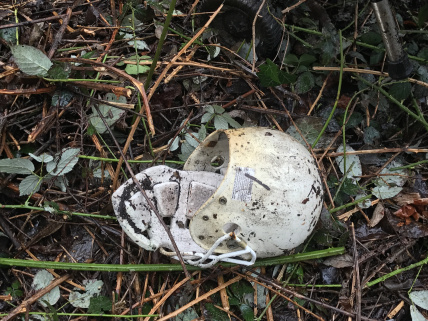
Home >> Source Reduction Campaign >> 3 Step Plastic Challenge
| Home | Source Reduction | Friends of Green Friends | Newsletters |
| Gardening | Resources | What You Can Do | Embracing The Trees |
| One Piece at a Time | |
 "Nature on its own is indeed beautiful and clean. The hills and rivers do not need us to clean them. In fact, it is nature’s water which cleans us; it is trees which purify air for us. Because we have littered, we have spoilt its pristine beauty." - Amma |
I once read that every piece of plastic that ever existed still exists. While that statement has been challenged (politifact.com), there is no disputing the fact that plastics decompose very slowly and some may never decompose.
We have certainly seen evidence of the long life of plastic in the GreenFriends Greenbelt Restoration Project that Seattle satsang members are leading. The areas we are restoring have been covered by blackberry, ivy and bindweed vines for 30-60 years. With the aid of Green Seattle Partnership, the City of Seattle Parks Department, and volunteer groups such as students from the University of Washington’s Introduction to Environmental Science course, we are helping to return this stretch of Greenbelt to the beautiful forest it once was. When the Seattle Parks Department staff initially cut down the blackberry vines for us, they discovered the foundation of a house that had burned down in the 1950’s. We found many plastic items in or near that foundation. It appears that a lot of plastic trash was also thrown into the greenbelt by nearby residents and passersby. My house borders this Greenbelt property. When I cleaned out my bird houses last winter, I found a sizable bird nest. I was shocked by the amount of plastic a bird had used in constructing it (Photo 1). Photo 2 shows the pile of plastic I removed when I took the nest apart. |
| My experience with the bird nest opened my eyes to all the plastic that was in our greenbelt site. After than, anytime I walked through the property, I saw that the ground was littered with flecks of plastic. I worried about the toxicity of the plastic and also remembered a photo that I once had seen of the contents of the stomach of dead albatross at Midway Island. (See Photo 3.) I felt an urgency for us to remove as much plastic from the site as possible, before the birds could start using it for nesting material. |
| We invited Seattle satsang’s Bala Kendra group (our spiritual community’s children’s group) to come pick up litter. Photo 4 and Photo 5 show the litter they picked up in one hour’s time. In addition to this diverse pile of garbage, they removed many small flecks of plastic from the ground. |
|
Much of the trash our volunteers have removed from the site during the past year has been plastic. While the items might be dirty, as you can see in the photos below, many of them look basically the same as they did decades ago.
|
 |
 |
 |
 |
 |
 |
 |
 |
| Yesterday, I picked up the remains of a pile of burlap bags that we use to cover the ground after we clear it. Under the pile I saw this: |
 |
| I went back later and pulled out some of that trash so that I could photograph it. There was rope, candy wrappers, a garden stake, line string for a trimmer/edger, a plant sign, carpet pad and assorted other kinds of plastic. |
 |
|
Today I remembered another piece of plastic I had recently seen. I went back to that place and began to pull the plastic bag out of the ground. Below is what I uncovered. Often, when I pull out plastic, what emerges is even bigger than this!
I wonder if we will ever come to the end of the plastic trash on this site! Maybe not, but every piece someone removes helps reduce the negative impact that humans have had on nature in this space and gives nature a chance to restore itself to its pristine beauty. Do you have a personal story to tell about how you are working to address the problem with plastic? Send it in (preferrably with photos) to info@greenfriendsna.org |
|||
| The Current Problem | ||
 |
 |
 |
| Home | Source Reduction | Friends of Green Friends | Newsletters | Resources | What You Can Do | Contact Us |
For more information, e-mail info@greenfriendsna.org |
||||||






